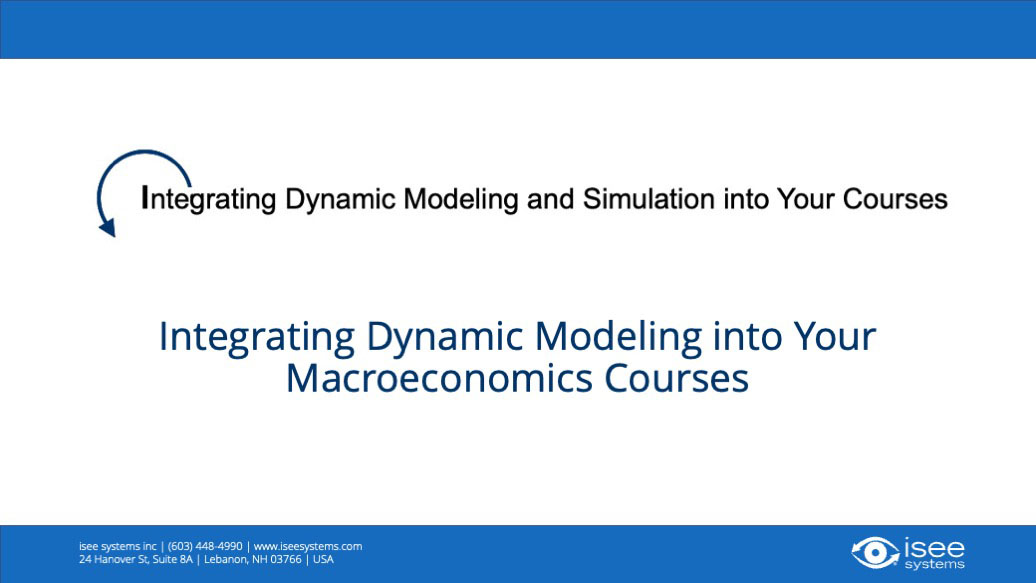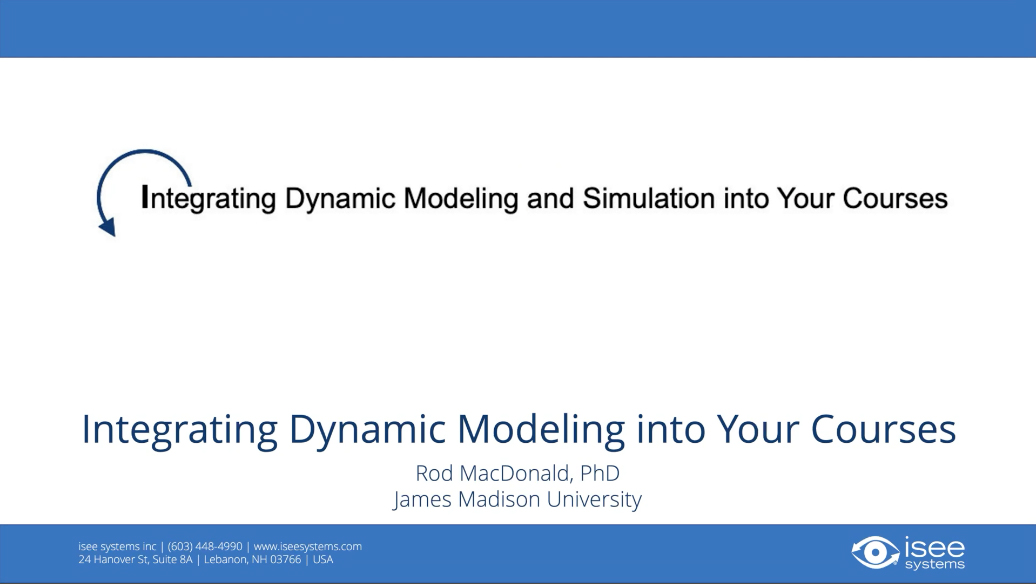Integrating Dynamic Modeling and Simulation into Your Courses webinar series
Each webinar in this ongoing series will be presented by a guest professor from a different field.
Presenters will highlight how they incorporate dynamic modeling into their courses and give tips
and tricks they've learned along the way. View the schedule for upcoming webinars and access previous
webinars below.
In this webinar, Professor Robert Alexander of Kenyon College explores how dynamic modeling enriches
environmental courses through an in-depth examination of the Mono Lake case study. He guides students
step-by-step through the process of building a model, demonstrating how models are constructed, applied,
and how they influence policy decisions. The class engages in policy experiments and compares model
predictions with the actual 1994 decision, offering a practical look at the intersection of science and policy.
In this presentation, Dr. Diana Fisher shows how she introduced System Dynamics (SD) modeling into high school algebra and
calculus classes. Her focus was always to have students build SD models, finding the process transformative for both her students
and herself. In calculus, she extended what she had done in algebra and had students translate differential equations to SD
models. She also presents some useful applications of AI in helping K-12 teachers infuse SD into their classes and create
systems thinking assessment questions for their math classes.
In Dartmouth’s Spring 2022 term, Professor Steve Peterson launched a new course, entitled Future of Energy
Systems. This course, aimed at less-quantitative undergraduates, used thinking-in-systems tools and
approaches to help students explore energy production, distribution, and use in the context of climate
change. In this webinar, Steve provides a brief overview of the course, focusing on how he used systems
approaches to gain insight into the potential evolution of energy systems.

In this webinar, Professor David Wheat discusses the challenges of developing and delivering a system
dynamics-based macroeconomics course for students with no experience in either System Dynamics (SD) or
macroeconomics. He also discusses how he uses his new textbook – Useful Macroeconomics (Kendall-Hunt 2024) –
and his MacroLab Lite model in the course.
His presentation begins with a brief introduction that explains his motivation for using SD as a tool for
learning macroeconomics. The remainder of the session is devoted to his teaching strategy for enabling
students to gain a general understanding of systemic reasons for the U.S. economy’s characteristic performance
patterns since 1950, with a focus on inflation, unemployment, and economic growth. Students explore the model
economy one submodel at a time, among the trees as it were. He describes simulation experiments that help
students maintain sight of the surrounding forest – the interdependent submodels within the Supply and Demand
sides of the economy, and also the critical interdependence between those two sides. Before closing, he
provides a brief preview of the textbook’s Second edition and his work on a two-volume set of supplemental
materials: a Student Learning Activities Guidebook and an Instructor’s Resource Manual.

Ten years ago, as part of its undergraduate curriculum renewal, the Integrated Science and Technology (ISAT)
program at James Madison University recognized the importance of training students in holistic problem-solving
as part of their STEM education. The faculty saw that society’s challenges were growing increasingly complex
and multi-dimensional and wanted to equip graduates with the skills needed to address these issues.
In the fall of 2016, Rod MacDonald joined ISAT, and the program decided that system dynamics would
be the primary tool to help students understand the complexity of modern society. Currently, ISAT
requires students to take a systems thinking course, a semester-long introduction to system dynamics
modeling course, and a year-long course focused on applying modeling to a specific problem area. In
addition, several electives involve system dynamics modeling.
In this seminar, Rod provides an overview of the program before focusing on the materials and sequencing
of concepts used in the undergraduate Introduction to System Dynamics Modeling course. The goal of the
webinar is to give attendees fresh ideas on how to deliver system dynamics materials effectively, as
well as to invite suggestions on improving both the course content and its delivery.
For additional information, see The System Dynamics Learning Guide
by Mike Deaton and Rod MacDonald and
its materials on Google Drive.
Dr. Russell Richards highlights how he has used system dynamics modeling to engage with students at the University of
Queensland, both in terms of students specifically studying the use of system dynamics and those studying other disciplines.
He has sought to merge gamification and system dynamics to develop bespoke models that can be used in the classroom to
provide an immersive experience. This seminar showcases some of these gamified models—all of which have been
designed using Stella Architect, and some of which have subsequently been transferred to gaming software (Unity3D).
This journey into gamification has been a learning experience for Dr. Richards himself, and he will not only cover
what went well but also what didn’t.
Learn how to incorporate dynamic modeling and simulations into your civil engineering courses with Dr. Rajib
Mallick from the University of Texas at El Paso. Dr. Mallick has taught civil engineering for over twenty-three
years. In this webinar, he discusses how he introduces the principles of system dynamics, demonstrates them with
respect to problems in transportation engineering, and helps develop strategic views of problems and solutions to
facilitate the development of policies that would lead to long-term benefits.
Convincing your administration
Professors are often required to show their administration how software is beneficial to their curriculum before
they can adopt it. Several of our partners have offered the following points that are beneficial when presenting
dynamic modeling and simulations to their administrators.
-
What is dynamic modeling? Dynamic modeling is a problem-solving tool. It shows how a complex system
reacts to various inputs or events over time and can indicate weaknesses before they become major issues.
Models help predict behavior and allow people to conduct trial and error simulations to determine the best
outcomes and optimize performance.
-
How will it improve the current curriculum? Incorporating dynamic modeling into your courses will
reinforce the core concepts of the field. Modeling is a wonderful teacher. As students model complex
problems, they achieve a greater understanding of the system as it currently exists, what factors could
be causing the problem, and solutions that have been or could be applied.
Stepping back and taking a systemic view allows students to look beyond the linear problem-solving
perspective and identify pitfalls and knowledge gaps. Models allow them to visually see how different
sectors (i.e. species, departments) interact and the impact each has on the system. They begin to acknowledge
quick fixes that work today may not be the best for the future.
-
How will it impact students? By studying dynamic modeling, students learn to take responsibility
for their education. Instead of simply taking a result at face value from books or lectures, they discover
facts for themselves by developing what-if scenarios and seeing how they play out. Topics that interest
them can be explored deeper, creating excellent opportunities for projects, capstones, or theses.
Students' knowledge evolves as they work through the modeling process to find the optimal solution.
They also learn that problem solving is a social, collaborative process. To determine a problem’s
systemic causes, they must often rely on not only their modeling skills, but on the perspectives of
experts and stakeholders. To make an impact with their findings, they must develop a model that
communicates effectively to the public. These skills are highly sought after and will benefit their careers.
Student engagement
“Today’s students are tomorrow’s faculty, so it is important to inspire them.” -Dr. Rajib Mallick
We have had the privilege to see many spectacular student projects. To celebrate their work and
illustrate the diverse projects students have successfully completed using dynamic modeling, we have
created a “Show us your work” challenge.
We invite students to send us a video overview, no more than three minutes in length, of their
completed modeling project. We will post high-quality videos on our social media channels to both
highlight and share the student’s work.
Videos should include why you chose to work on that problem, what you learned or what were the key
takeaways from the model, and how dynamic modeling or Stella helped you find a solution.
Students should include their social media handles so we can tag them in our posts. Submissions
can be sent to support@iseesystems.com with the subject ‘Show us your work’ challenge. Submission
does not guarantee that the video will be posted.
Bibliography
These books and papers are recommended by our partner professors.
Fisher, D. (2017). Modeling Dynamic Systems: Lessons for a First Course. Lebanon, NH. isee systems, inc. Learn more.
Meadows, D. (2008). Thinking in Systems. White River Junction, VT. Chelsea Green Publishing. Learn more.
Richmond, B. (2004). Introduction to Systems Thinking: Standard Edition. isee systems,inc. Learn more.
Roberts, N. (1983). Introduction to Computer Simulation: The System Dynamics Approach. Reading, MA. Addison-Wesley. Learn more.
Senge, P. (2006). The Fifth Discipline: The Art & Practice of The Learning Organization. New York, NY. Doubleday. Learn more.
Mallick, R. (2023). System Dynamics for Complex Problems in Pavement Engineering. Raton, FL. CRC Press. Learn more.
Hargroves, J. (1998). Dynamic Modeling in the Health Sciences. New York, NY. Springer Science+ Business Media. Learn more.
Sterman, J. (2000). Business Dynamics: Systems Thinking and Modeling for a Complex World. New York, NY. McGraw-Hill Education. Learn more.
Ford, A. (2009). Modeling the Environment. 2nd ed. Washington, DC. Island Press. Learn more.
Jägerskog, A. S. (2020). Using Visual Representations to Enhance Students’ Understanding of Causal Relationships in Price. Scandinavian Journal of Educational Research, 65(6), 986–1003. Learn more.
Wheat, I. David. (2024). Useful Macroeconomics. Kendall Hunt Publishing. Learn more.
Grading Causal Loop Diagrams
Kastens, K.A., Wakeland, W., Shipley, T.F. (2024). Developing and Field-testing a Rubric for Evaluating Students' Causal Loop Diagrams. Proceedings of the International Systems Dynamics Conference. Learn more.